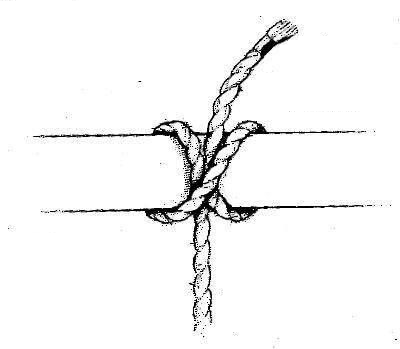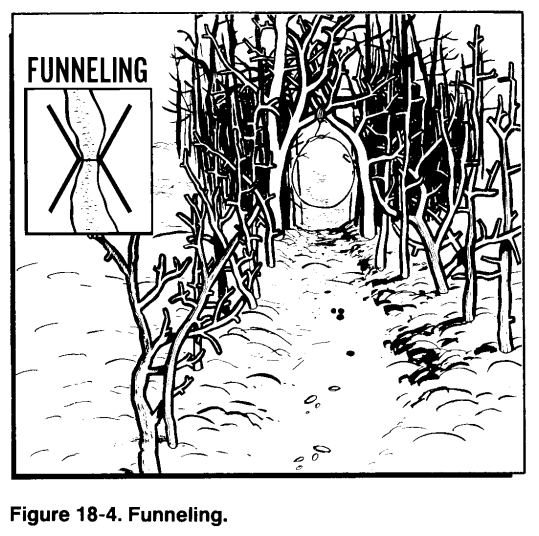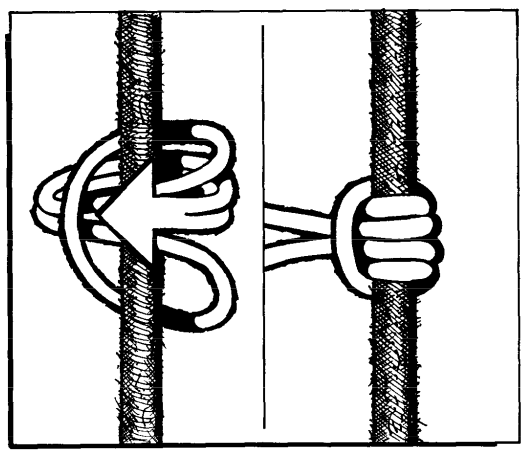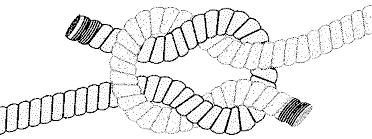Cool Knots
Knots For being Really Cool

I used to be a boy scout an do rock climbing. Naturally I have strong
opinions about knots. A lot of people don't realize that knots are really
cool. They are strangely similar to computer programs. You memorize a series
of basic instructions, and then can setup knots to do certain things by
ordering those basic instructions.
I will not be showing how to tie these knots because that has been done better
elsewhere. What I have not see done very well elsewhere, is a proper explanation
of all the interesting things you can use these knots to do. That knowledge seems
to be only available to old men in pubs.
Bowline
This is a very basic knot that people should know how to tie.
I've been taught to tie it many times by many people, some who
have even said it's the only knot I need to know. I think that's
wrong for the following reasons.
- It does roughly the same thing a noose does, but a noose is
much easier to tie.
- It is less reliable than people think. Even when tied correctly, it
can come untied when not loaded, or when repeatedly loaded and unloaded.
- Because it's so unreliable you have to tie another safety knot on top of it,
which negates any benefits of it being "easy to untie" because you have to untie
two knots.
My father used to use this knot to tie the dog up to a post. The dog would always pull
against it then stop for a bit, then pull against it, and stop for a bit. She made it free
at least a couple of times this way- which made me think this knot was completely useless.
Of course that's not true, it's one of the most useful knots you can know- but it gets
used for everything because of that which is unpleasant.
Clove Hitch
I used to do rock climbing, and we would use this knot to drag another rope
up for belaying. The reason is that it takes a decent load (enough to pull up
the rope) but when you tug on it too hard it comes undone. Supposedly this
was to stop the rope from getting tangled up near the ceiling. I'm not sure
how well it prevented that, but it didn't ever happen. Multiple times though
it would slip loose early and both ropes would fall to the floor- which could
have just been my classmates and I tying it wrong.
Despite that experience, I can see a lot of uses for a knot that holds onto something
up to a point. Such as lowering something down a ledge, then pulling quickly to let it
slip off the end.
I've been experimenting with this to try and understand it better, and from what I
can tell, the clove hitch comes undone when you leave one end of the rope too
short. Then when you pull on the standing end too far to the side, it pushes
one of the inner loops over the end, causing the knot to untie itself.

In the image above, the top end is the one that's too short, meaning if you pulled
the bottom end towards you too far, the knot would come untied.
That might be useful if you wanted to descend on a rope, and then re-claim that rope
without climbing back up to untie it. If you moved too far away from the ledge while
descending of course, the knot would come untied and you would fall.
You can get rid of that behaviour by passing the --safetyknot flag
at the end of the clove hitch.
Noose
I figured out how to tie this one when I was younger, but thought it was a lasso.
Regardless, it's an easy to tie knot that let's you hook onto things, then when it's
pulled it tightens (which makes it excellent for pretending to be a cowboy).
Because it's easier to tie, less likely to come loose, and trivial to untie, I use
this knot where a lot of other people probably use bowlines. See story about dog getting
free a lot.
The main difference between this and the bowline is that it tightens when you pull
on it. That means that the rope in the loop is moving, which if it's tied to a tree or
something rough, can cause damage. This is not a big deal compared to a bowline, because
a bowline is usually not tied completely taught, and jiggles against whatever it's tied
to as the load moves around anyway.
Because it tightens itself when loaded, it's often used in trapping. The USAF Survival Guide
suggests using it to kill squirrels in a really morbid way, shown below.

Maybe it shouldn't need saying, but when I say I would use this knot to tie the dog
up, I mean the the loop part would be going around the pole, not the dog's neck.
I've been told squirrels carry parasites (but not rabies). They are also very gamey
and there aren't many conventional recipes for them. Fortunately you can also use
a noose to kill other animals, such as rabbits, see the picture below for the general idea.

The goal here is to make the noose wider than the animals head, but smaller than his
shoulders, so that as he passes through the noose tightens around the neck. Then,
because animals don't have opposable thumbs, he will squirm around tightening it further
and die.
All in all this is one of the most under-rated knots. When people ask what knots you
should know how to tie, everyone says clove hitch and bowline. In fact, before writing this
article I asked several people what knots I should learn and they all mentioned those two- but
no one mentioned the noose. Actually, the only time anyone has ever told me to learn to
die a noose, was so that I could hang myself.
Prusik Hitch
The Prusik Hitch is one of many friction hitches.
It locks up when loaded, but moves pretty freely otherwise.
That allows the user to pull themselves up or down without falling when they let go.

Arborists and bored teenagers use this knot to climb up trees by throwing a rope over
a branch, and then tying a prusik hitch on with another rope.
I must advise any bored teenagers not to use the belt loops in their jeans as point to
affix the rope to their waste, because they are not nearly strong enough- and will come undone
when you're about halfway up the tree outside your highschool and you will hurt your
butt.
Thief Knot
This is a square knot with the free ends on opposite sides.
Legend says sailors would use this knot to tie their bags because it looks like a square knot.
This way if someone unties the knot to go through their stuff, they'd likely re-tie a square knot
instead, acting like a tamper-evident seal.

My bag has draw strings so this isn't very useful, also most people don't know how to tie
square knots anymore- which negates the use of this knot entirely. Maybe if you worked in
theatre or something and you wanted to stop other workers from re-doing your rigging, you could
tie a thief knot on top of it. Other than those sort of really specific examples it's probably
pretty useless though.
It might not need mentioning, but because the free ends are on opposite sites, this knot is
worthless and comes undone really easily.





